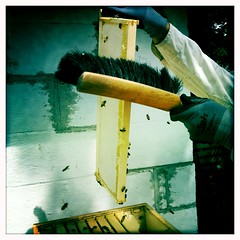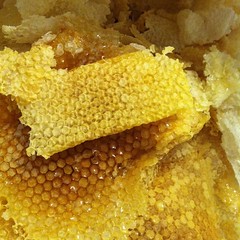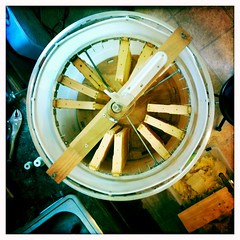 |
| the robbing commences |
So, here we are in the hives, searching for frames of capped honey. Let's be clear that a frame of capped honey is a beautiful sight. The wax is buttery and opaque, hinting at the wealth beneath.
 It is also heavy--an early indication when you reach for a frame that its full of the good stuff. The first thing to do is get the bees off the frame. As a general rule, there are usually fewer bees on capped honey to begin with because they aren't using that frame (if it is capped, they aren't eating it, and otherwise, they are tending to the frames with brood). But there will always be some bees, and there are a variety of ways to remove them. For brevity's sake we'll skim over the others and just note that we use the old fashion brush (see picture above). Admittedly, they hate it. But you are robbing them after all, so you've kinda already accepted a certain imbalance of justice.
It is also heavy--an early indication when you reach for a frame that its full of the good stuff. The first thing to do is get the bees off the frame. As a general rule, there are usually fewer bees on capped honey to begin with because they aren't using that frame (if it is capped, they aren't eating it, and otherwise, they are tending to the frames with brood). But there will always be some bees, and there are a variety of ways to remove them. For brevity's sake we'll skim over the others and just note that we use the old fashion brush (see picture above). Admittedly, they hate it. But you are robbing them after all, so you've kinda already accepted a certain imbalance of justice.
Once you've gathered all your frames, you contain your excitement and move inside (don't want to tempt the bees by extracting near them). Be sure that you have thoroughly cleaned your workspace and all tools and equipment.
The next step is to cut the wax cappings from the comb. The cappings are literally wax that bees cover ripe honey with to contain and protect it, designating it as storage. This is really the only wax that should be used for cosmetics (and is what we use for our lip balms & salves), because it is by nature clean and fresh.
Once you've cut away the cappings, take a moment to stop and admire the unique color of whatever-season honey you're extracting. Hold it against the light, squint, smile, whatever. Just notice it. Then, place it your extractor.
 |
| homemade extractor |
Our extractor is a little different, just like our bee suits are different (costumes we call them), because it is homemade. Such are the perks of having a carpenter/tinkerer/seamster on your team. Our extractor works the way commercial ones do, for the most part. That is, it spins the frames--which are placed like spokes in a wheel--utilizing centrifugal force to push the honey out of the comb. The honey flies out, hits the side of the extractor, and collects at its base, where you have a spigot for easy release. As you pour the honey from the extractor to your storage container, you filter out
 |
| filtering |
or other remnants.
And that, my friends, is all. Pure, raw, filtered honey. And it is soooo good!
After we harvested some honey from each of our city and country hives, we compared them. Woo hoo! Just like last year, we were super impressed with how bright, citrusy, floral, and generally fun the city honey was. Whatever you are doing, neighbor friends, please keep it up!

